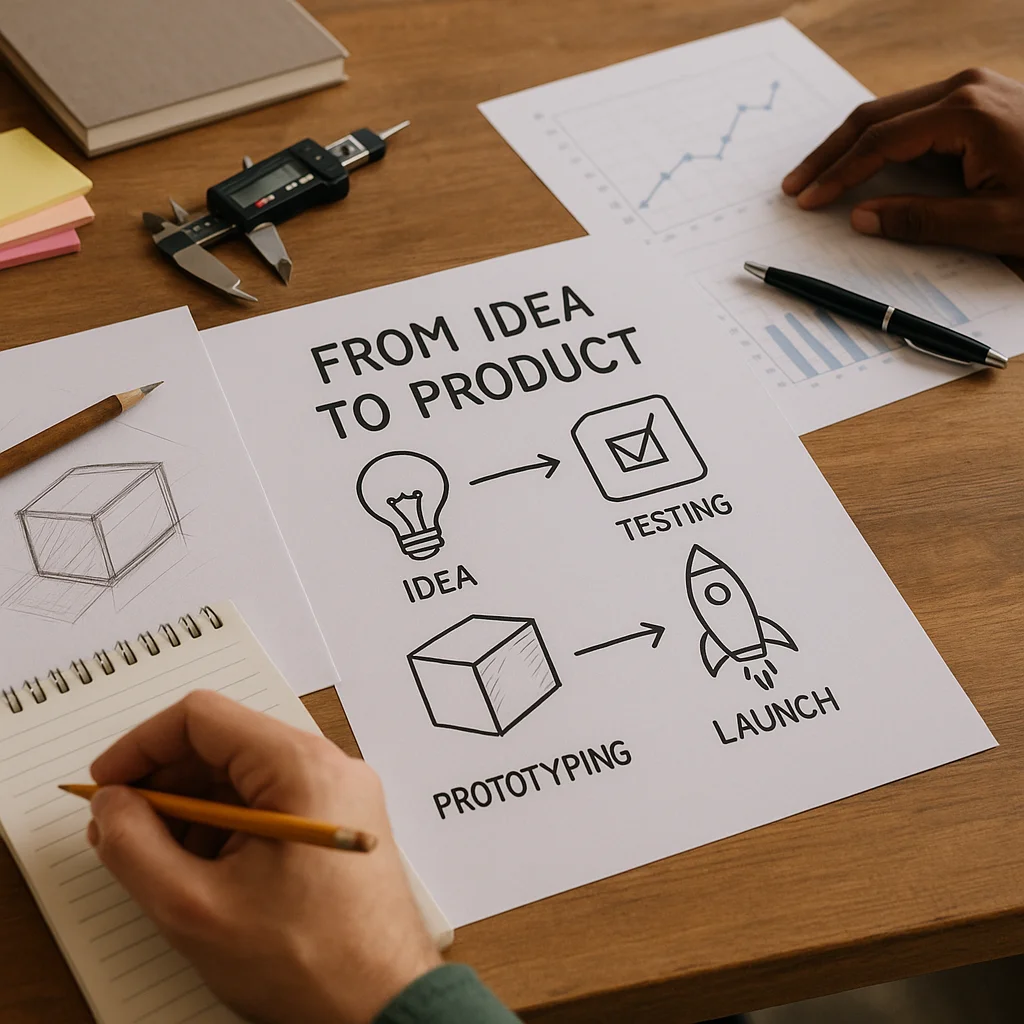How to Generate 10 Original Ideas Every Week

Why Consistent Idea Generation Matters
Consistently generating ideas is more than just a creative exercise; it is a fundamental habit that can significantly impact your personal and professional growth. When you make idea generation a weekly practice, you train your brain to think creatively on demand rather than waiting for inspiration to strike. This builds a mental muscle that allows you to approach problems and opportunities with a solution-oriented mindset.
Regular idea generation also increases your chances of producing truly original concepts. Ideas often need multiple iterations and combinations before they become innovative. By committing to a consistent schedule, you create a pool of raw material that can later be refined, tested, and implemented.
Moreover, maintaining a habit of weekly idea creation helps combat mental stagnation and creative blocks. Even ideas that seem impractical at first can spark breakthroughs when revisited later. This process encourages continuous learning as you explore new perspectives, experiment with different approaches, and remain curious about your surroundings.
Finally, consistent idea generation fosters a sense of discipline and accountability. It transforms creativity from a sporadic activity into a measurable skill. Over time, you start noticing patterns in your thinking, identifying areas where you excel, and uncovering opportunities you might have otherwise missed.
Setting Up Your Weekly Idea Routine
Creating a structured routine is essential for consistently generating ideas. Start by designating a specific time slot each week dedicated solely to idea creation. This could be an hour on Monday morning or Friday afternoon—choose a time when your mind is clear and focused. Treat this session as non-negotiable to build a strong habit.
Next, prepare a comfortable and distraction-free environment. Keep a notebook, digital app, or whiteboard handy to capture ideas as they come. The goal is to make the act of recording ideas seamless and effortless, reducing any friction that might discourage your practice.
To guide your sessions, create a simple framework. For example, set a target of generating 10 ideas in one sitting. You can break this down into categories such as problems to solve, improvements to existing products, or completely new concepts. This structure provides direction without stifling creativity.
Incorporate a review and reflection step at the end of each session. Quickly evaluate which ideas have potential, which need refinement, and which can be set aside. This habit helps you track progress and ensures that your weekly efforts contribute to a growing pool of actionable concepts.
Finally, keep your routine flexible yet consistent. Life can be unpredictable, so allow yourself minor adjustments without skipping sessions. Consistency over time is more important than perfection, and even shorter or slightly delayed sessions maintain the rhythm necessary to develop a robust idea generation habit.
Setting Up Your Weekly Idea Routine
Establishing a reliable routine is crucial to generating ideas consistently. Begin by selecting a specific day and time each week dedicated exclusively to idea creation. Treat this slot as an important appointment with yourself. Choosing a moment when your mind is naturally alert and focused—for example, early mornings or late evenings—can significantly improve the quality of your ideas.
Prepare your workspace to support your creative flow. Whether it’s a quiet corner, a café, or a digital tool, ensure it is free of distractions. Having a notebook, sticky notes, or a digital app ready allows you to capture thoughts immediately, making it easier to sustain momentum during the session. The goal is to make the process effortless and habitual.
Develop a simple framework for your sessions. For instance, aim to generate 10 ideas per week and organize them into categories such as problems to solve, opportunities for improvement, or entirely new concepts. This provides a structured approach without limiting your creativity, allowing your brain to explore multiple angles.
Include a review step at the end of each session. Spend a few minutes evaluating which ideas have the most potential, which ones require further exploration, and which can be archived for later. This reflection ensures that your weekly practice produces a tangible pool of actionable ideas rather than just a collection of thoughts.
Finally, maintain flexibility within consistency. Life can be unpredictable, so it’s important to adapt your schedule when needed while keeping the habit alive. Even shorter sessions or slightly shifted days are better than skipping entirely. Over time, this consistent practice trains your brain to generate ideas reliably, making creativity a natural and repeatable skill.
Using Observation and Inspiration from Your Environment
One of the most powerful sources of new ideas is your immediate environment. By paying close attention to the world around you, you can uncover insights and opportunities that might otherwise go unnoticed. Develop the habit of mindful observation, noticing small details, patterns, or inefficiencies in everyday situations.
Start by documenting what you see. Keep a notebook or digital tool handy to capture interesting occurrences, unusual behaviors, or innovative solutions you encounter in daily life. Even mundane experiences, such as the layout of a store, the flow of a website, or the way people interact with a product, can trigger valuable ideas when analyzed thoughtfully.
Expose yourself to a variety of stimuli. Visit new places, read diverse books, listen to podcasts, or attend events outside your usual routine. Each novel experience provides fresh perspectives and can spark ideas by allowing you to connect seemingly unrelated concepts. Inspiration often arises from contrasts or unexpected juxtapositions in your surroundings.
Engage with other people actively. Conversations with colleagues, friends, or even strangers can reveal different viewpoints and highlight problems or desires you may not have considered. By observing how others approach tasks or express needs, you gain practical insights that can serve as the foundation for innovative ideas.
Finally, train yourself to ask questions constantly. Instead of passively observing, inquire “Why does this exist?”, “How could this be improved?”, or “What if this were different?”. This mindset transforms your environment into a rich source of inspiration, ensuring that you are consistently collecting material for new and original ideas.
Mind Mapping and Brainstorming Strategies
Mind mapping and brainstorming are powerful techniques to structure your thinking and generate multiple ideas quickly. Start by creating a central concept in the middle of a page or digital canvas. From this core idea, branch out into related themes, problems, or opportunities. Each branch can then split into smaller sub-ideas, allowing you to visualize connections and explore variations you might not have noticed otherwise.
During brainstorming sessions, it is crucial to suspend judgment. Encourage yourself and others to produce as many ideas as possible, no matter how unconventional they may seem. This practice fosters creative freedom and often leads to unexpected insights. Use techniques like listing, free association, or asking “what if” questions to expand the pool of ideas rapidly.
Combine individual and group brainstorming for maximum effect. Personal sessions allow for deep, uninterrupted thinking, while group sessions benefit from diverse perspectives and collaborative energy. When working in a group, employ rules such as deferring criticism, building on others’ ideas, and encouraging wild suggestions. These principles help maintain a positive, productive environment where creativity can flourish.
Leverage tools and visual aids to enhance your strategy. Sticky notes, whiteboards, or digital mind mapping software help you move ideas around, group related concepts, and identify patterns. Visual representation makes it easier to spot connections, redundancies, or gaps in your thinking, which can spark further ideas and refinements.
Finally, revisit and iterate on your mind maps and brainstorming results regularly. Ideas that seemed incomplete initially can evolve into actionable concepts when combined with new insights. This ongoing process ensures that your approach to generating ideas is not only systematic but also continually expanding and improving.
Ready to showcase your project?
Join thousands of developers and entrepreneurs who have already listed their websites in our directory. Get discovered by potential users and grow your audience.
Free to list • Instant approval • No hidden fees
Frequently Asked Questions
Why is consistent idea generation important?
Related articles

How to Spot Emerging Trends to Inspire New Features
Learn practical methods to detect emerging trends early, analyze user behavior, monitor communities, and draw inspiration from competitors to turn insights into actionable product features.

Turning Negative Feedback Into Innovation Opportunities
Learn how to transform customer complaints and critical feedback into actionable insights that drive product improvements, creative solutions, and business growth. Discover practical strategies to listen, analyze, and act on negative feedback effectively.

The Art of Saying No: Avoid Feature Creep Early
Feature creep can silently derail early projects, inflating costs and timelines. Learn how to set boundaries, prioritize effectively, and say no without burning bridges.

The Psychology of Creativity: How to Spark Original Thinking Daily
Creativity is not a gift reserved for a few—it’s a skill rooted in psychology and daily practice. By understanding how the mind generates ideas, you can design routines, adjust your environment, and embrace curiosity to unlock original thinking. This article explores proven strategies to overcome barriers and spark creativity every single day.

The Role of AI in Modern SEO: What Founders Need to Know
Artificial Intelligence is reshaping SEO, moving beyond keywords to focus on intent, personalization, and smarter strategies. For startup founders, understanding these changes is critical to stay visible and competitive. This guide explores how AI impacts SEO, the tools available, and actionable steps to integrate AI into your growth strategy.

Techniques to Generate Original Ideas Consistently
Generating original ideas consistently is a challenge for many, but it’s a skill you can master. This article explores proven techniques, habits, and strategies to spark creativity, overcome mental blocks, and turn innovative concepts into actionable results. Learn how to keep your ideas flowing every day.

How to Turn an Innovative Idea into a Concrete Product
Turning an innovative idea into a concrete product is an exciting but challenging journey. This guide walks you through validating your concept, prototyping, testing with users, building a business model, and preparing for a successful launch. Learn how to bring your vision to life, step by step.

How to Prioritize Features When Starting a Project
Starting a new project can be overwhelming with countless features competing for attention. Prioritizing the right features early on is key to delivering value quickly and efficiently. This article explores proven methods and frameworks to help you evaluate, select, and focus on features that align with your goals, stakeholder needs, and user expectations — ensuring a successful project launch.

The Benefits of Networking With Like-Minded Innovators Online
In today’s fast-paced digital era, networking with like-minded innovators online offers unparalleled opportunities for creativity, collaboration, and professional growth. By joining virtual communities, innovators can exchange ideas, overcome challenges, and build meaningful relationships regardless of location. This article explores the key benefits of online networking and how it can accelerate your innovation journey.